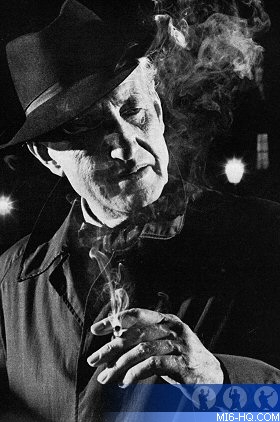 |
| |
MI6 reviews the death-defying second James Bond novel, "Live And Let Die", published by Ian Fleming in 1954...
|
|
Live And Let Die: Reviewed
3rd September 2009
James Bond is back in the
hard-hitting 1954 novel: "Live
And Let Die". After 007's debut on the Casino
Royale mission, the British spy is a rougher, more
disconnected but nevertheless determined man. His errors
of judgement on the Royale job still haunt him and here, Ian
Fleming introduces a little of the wispy continuity
that ties the James Bond literary cannon together.
"Live And Let Die" begins with a serene "cold open" describing the events as 007 arrives in the United States, at Idlewild Airport, New York and is ushered through customs and into a saloon car as if he was royalty. His mission is yet unknown but he muses - with a tinge of Fleming snobbery - that the Americans are being abnormally friendly. As if by answer, Bond is dropped in a lavish hotel suite to find himself face-to-face with his CIA buddy, Felix Leiter. Fans will enjoy the American/English banter between these two confirmed "old friends" - especially those who are fresh from reading Casino Royale.
Right: 1st edition Jonathan Cape hardback (UK)... |
|

|
The novel then jumps back to explain the reason 007 is in New York: the gold smuggling of a Harlem gangster, Mr. Big (really named Buonapart Ignace Gallia). Big has a secret and a very smooth operation, such that the FBI have been unable to track the mobster, but Bond's real interest turns out to be that The Big Man is an agent of SMERSH - the Soviet spy-execution squad. Depicted as a shady character, Mr. Big gets a slim portion of the novel dedicated to him. In fact, Bond only comes face to face with the villain on two occasions. The first, in the basement of a Fillet of Soul restaurant and club and next when Bond is very much his prisoner on a lonely Jamaican island. Despite the vague mentions of the man himself, the devil is in the details, and Big has his goons believing that he is the zombie of Baron Samedi - Voodoo spirit of the dead. For all the eccentricity of Mr. Big and his smugglers, the latest "Bond girl", clairvoyant Solitaire is a bit neglected in a chopping-changing narrative.
"'This case isn't ripe yet. Until it is, our policy with Mr Big is to live and let live.' Bond looked quizzically at Captain Dexter. 'In my job,' he said, 'when I come up against a man like this one, I have another motto. It's live and let die!'"

Above: A moody portrait of 007's creator, Ian Fleming...
|
|
Fleming's second attempt is darker, in places, than the prior and the gutsy move on Fleming's behalf to make every villain a negro gives "Live and Let Die" a distinctive flair. Not only will the suspicion and the power of the unseen villain haunt readers, but "Live And Let Die" is the birthplace of some of the most memorable and horrible James Bond sequences.
Whilst the events bare little resemblance
to the 1973 film of the
same name, some iconic sequences devised by Fleming for this
novel have since made it onto film. For example the keel-hauling
episode seen in "For Your
Eyes Only" is comparatively tame to the torturous
descriptions of Bond and Solitaire's novel-bound ordeal.
A rather good representation of another two "Live and Let Die" sequences can be found in the on-screen adventure, "Licence to Kill". Felix is kidnapped by the sadistic villain - in the novel known as The Robber - and mercilessly tortured by feeding the CIA-man to a ravenous Great White Shark, but unlike the film, Fleming spares us much of the gore. However, when Bond returns to the Florida warehouse and, after a massive shootout, feeds The Robber to the shark himself, readers will get a sense of Bond's sickening disgust mixed with a willful revenge. |
"Live And Let Die" is often lost in
fans' memories as a bit of a non-event. Yet, on closer inspection
this novel is the breeding ground for some of the most interesting
sequences concocted by Ian Fleming throughout his career as an
author. It is perhaps let down by the fact that 007 is not a
decisive victor. For much of the narrative he is played by Mr.
Big and even in the gruelling climax, James Bond's survival comes
down to sheer luck. Another glaring and questionable element
to this Bond novel is the unashamed slew of potentially racist
comments which creep into Fleming's narrative. One might question
the boldness of his choice to pitch this plot as second novel.
Why would he risk the success of the series on a daring move
such as this? Even in hindsight we will never know. Despite the
glitches along the way, 007 gets the job done in a tense and
intriguing narrative.
This is a realistic, reckless and surprisingly enchanting novel - if only in a shameless (some might say sadistic) way.
Despite the "set-piece" style narrative - moving from one ordeal to the next as if a mechanical production-line of action - "Live And Let Die" ticks many of the required boxes: one of the spookiest villains of the cannon, interesting and well-depicted locations and we certainly feel the danger deep within James Bond's second literary adventure.
"Let me illustrate to you, by an example, how my mind works. We will take the method I have decided upon by which you are both to die. It is a modern variation on the method used in the time of my kind patron, Sir Henry Morgan. In those days it was known as 'keel-hauling'..."
Right: 2008 artwork for "Live And Let Die" by graphic artist Michael Gillette... |
|

|
MI6 Rating

Capsule Reviews
A snorter. From first word to last.. the reader is compelled to surrender to a superb storyteller.
- Time & Tide
Speed... tremendous zest... communicated excitement. Brrh! How wincingly well Mr Fleming writes.
- Sunday Times
Don't blame me if you get a stroke.
- The Observer
Mr. Ian Fleming is without doubt the most interesting recent recruit among thriller writers. The second aventure of his Secret Service agent fully maintains the promise of his first book. . .containing passages which for sheer excitement have not been surpassed by any modern writer in this kind.
- Times Literary Supplement
An ingenious affair full of recondite knowledge and horrific spills and thrills
- The Times
Related Articles
 Live And Let Die Coverage
Live And Let Die Coverage
 Ian Fleming Centenary
Ian Fleming Centenary